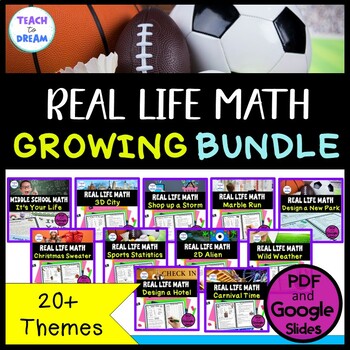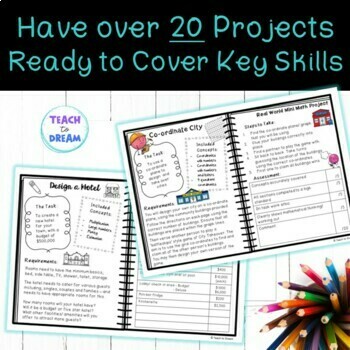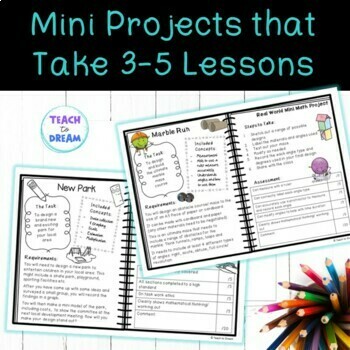Real World Math Mini Projects | Year Long Math Bundle PBL Grades 4th 5th 6th 7th
- Zip
What educators are saying
Products in this Bundle (21)
showing 1-5 of 21 products
Description
Make math skills more exciting with these extensive range of Math PBL activities. The growing bundle of real life mini math projects has been developed to be completed by teachers that have limited time. Each Math project covers a range of math skills and provides students with the opportunity to transfer their knowledge. It has been designed for students in grades 3 to 7. (Mostly for 4-7).
Each math project is designed to run between 3-5 lessons (excluding 'It's Your Life' - 10 lessons) depending on how much time you wish to allocate to the tasks.
The projects are easy to follow and can either be teacher run or student driven.
By purchasing this BUNDLE YOU ARE SAVING 30% OFF the individual price of each resource. You will also receive one math choice board FREE in this bundle pack.
Each Project in this resource includes:
✔ Student Project page with task and requirements.
✔ Teacher assessment
✔ Self/ peer assessment
✔ Working out/ design pages
** Suitable for both USA and UK/ AUS classroom.
✎ Titles of resources currently included in this bundle (18+ resources):
- Real world math project - It's Your Life
- 2D alien toys (2D shapes)
- 3D city (3D shapes)
- Dine at mine (Money, budgeting)
- Marble run (angles, measurement)
- Shop up a storm (money, percentages, budgeting)
- Sports Statistics (mean, median and mode)
- Design a hotel (money, multiplication, area)
- Wild Weather (data collection, graphing)
- Famous Landmarks (measurement, angles, 2D & 3D shapes)
- Dream Bedroom (perimeter, area)
- Design a new park (data collection, measurement, multiplication)
- Fancy Feast (money, budgeting)
- Plan a Party (money, budgeting)
- Zoo Days (timetable, 24 hour time, time duration)
- Carnival Time (money, time, budgeting)
- Marble Maze/ obstacle course (angles, measurement)
- Crazy Christmas Sweater (2D shapes, geometry)
- New World (co-ordinates)
- Coordinate City (co-ordinates)
This project can be used in many ways, including:
1. At the end of a unit of work to test knowledge.
2. Fun Friday Math lessons.
3. Group work
4. For fast finishers
5. Fun projects for students to complete for homework.
BUY the BUNDLE and SAVE 30%!!
~~~~~~~~~~~~~~~~~~~~~~~~~~~~~~~~~~~~~~~~~~~~~~~~~~~~~~~~~~~~~~~~
You may also be interested in the following resources:
Do your students love to hear about what you get up to outside of school? Have fun with these projects that have students completing MATH to help you solve daily issues; help plan a pizza party, create some pixel art, design a guest house and more!
TEACHERS LIKE YOU SAID…
⭐️⭐️⭐️⭐️⭐️ Grey's. G says, "This gave me a starting point for enrichment math projects for my students both online and in person, and everything in between. What a year! But having resources like this help with our transitions back and forth."
⭐️⭐️⭐️⭐️⭐️ Hema. T says, "I am planning for next year and I find this resource really helpful to achieve my goal to create fun and engaging lessons. Thanks."
⭐️⭐️⭐️⭐️⭐️ Shawna. W says, "Authentic and engaging activities."
*I really value your feedback*
I try to go over the work carefully to ensure no errors, however, occasionally I might miss something. If you find an error please email me and I will fix it straight away. Thanks!





